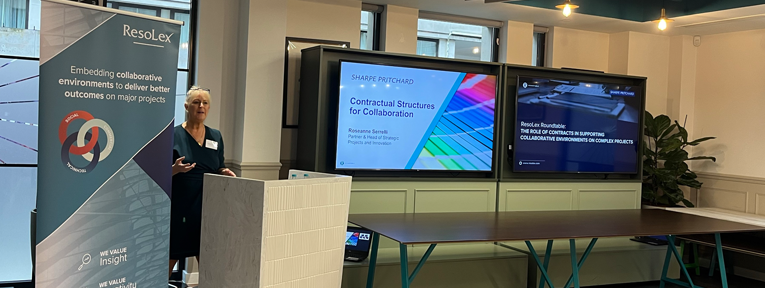
Apr 26, 2024 | Roundtables
On the 23rd of April, we welcomed Roseanne Serrelli, Partner at Sharpe Pritchard for a discussion on how contracts can be used to help embed collaborative behaviours on complex projects.
The session was opened by our Chief Executive, Edward Moore, who gave the attendees an overview of the evening and an introduction to the topic.
Ros began her presentation by explaining that the terms used in these ‘collaborative contracts’, e.g. alliances, enterprises, partnerships – have no specific legal definition. Any individual party involved with the contract is likely to interpret these terms differently. The key when looking to develop a contract which supports a collaborative endeavour is to focus on attention on the purpose of the relationship, rather than the term used. This approach has the benefit of shifting the focus away from risk transfer and instead puts the focus on risk avoidance and resolution.
The level of collaboration built into a contract can therefore be bespoke based upon the need, rather than starting with a pre-populated document. Options exist along on a spectrum from a light-touch arrangement to full alliances with shared legal risk, reward and finances. When developing a contract, it is worth thinking of the options as a menu from which the appropriate provisions can be selected based upon what the client intends to achieve.
Ros talked through several examples of different collaboration systems in existence, some of which have been discussed at previous ResoLex roundtables:
- Project 13 – not a contract itself, but an ecosystem and ethos for delivery that focuses on achieving outcomes rather than on the inputs.
- NEC Alliance – a single contract to which all are parties, including the client. This often works better on an ongoing programme with repeatable work, where the goal is to incentivise shared responsibility. This is more difficult on single projects where there may be more single points of failure that cannot be shared easily between participants.
- X12 – An option within NEC contracts that seeks to support multi-party collaboration, including containing a common set of objectives for all parties.
- FAC1 – An overarching framework that sits above individual contracts and contains items that need to be supported by those contracts, such as early warning systems.
Regardless of the form of the contract, there were some key takeaways about what is needed to ensure collaboration can be effectively supported:
- A defined governance structure with clear roles and accountabilities (often in a RACI matrix) – make it straightforward for people to understand who is doing what in the contract environment (and be clear that accountability is not the same as liability!)
- A clear decision-making process – the process may evolve over the lifetime of a project or differ in different parts of a programme, but it needs to be set out clearly and communicated to everyone involved.
- Set up Core Groups and Boards – these do not need to be over-engineered. They should have clearly defined objectives and discussion/decision points.
These structures provide a foundation for a successful collaboration. Having a contract that does not enable the environment you want will undermine your project from the start, though equally, having the perfect contract is meaningless if people do not engage in the right ways of working.
The contract underpins the practical side of collaboration; namely regarding people and their behaviours. When setting up for success, the behaviour of the joint team will be a key factor in how the benefits of these structures and processes are maximised in the project or programme environment.
The development of appropriate ways of working should consider some key questions, including but not limited to:
- Will the arrangement require co-location or jointly employed resources?
- What is the communications strategy? Will there be joint messaging from all parties? Will there be common branding and a ‘united front’ when facing the public?
- What are the processes for change or bringing in new people?
- What is the process for sub-contracting? Does the client need to approve any additions?
- How is the project insulated from outside noise (e.g. political pressures) to enable the team to focus on delivering the outcome?
- What do you do when things go wrong? It cannot be assumed, even with the perfect contract and the best people for the job, that there will never be an issue or point of contention between the parties. Provisions should be included in the agreement to enable parties to exit as necessary. Though counterintuitive, Ros shared that her experience is that providing clarity about the exit process provides comfort to the parties and in fact, often encourages parties to stay in contract and work through the challenges.
The session closed with a stimulating discussion on what needs to be done to try to build more collaborative environments in projects and programmes and how contracts can facilitate that, recognising that they are usually the starting point for the relationship. Points were raised in the room on the importance of ‘selling’ the benefits of this approach, particularly to clients when setting up a project and to politicians who may be overseeing major schemes. The conversation was a good reminder of the need to take the time to clearly define the required outputs and outcomes of a scheme before diving in, in order to set up the contract and environment that best facilitates these outcomes.
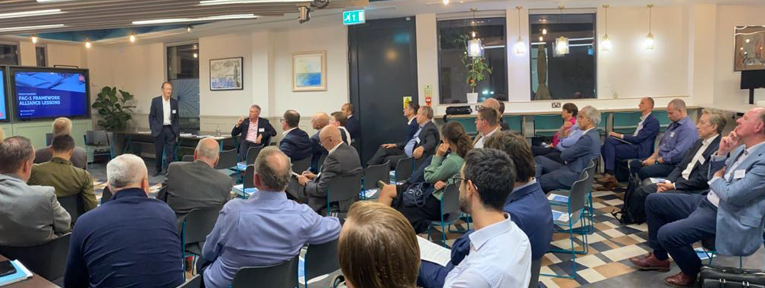
Oct 18, 2023 | Events, Roundtables
Last week, we were delighted to be joined by Professor David Mosey CBE for an update and lessons learned since the launch of the FAC-1 Framework Alliance Contract.
Ed Moore opened the session, commenting that David had first introduced the FAC- 1 Framework to the ResoLex audience at a previous roundtable event in February 2018. It was therefore heartening to see the traction the framework has achieved over the last five years.
David began his presentation by explaining that the FAC-1 is a multi-party framework alliance contract that integrates the procurement and delivery of one or more different projects, with the ability to connect multiple contracts awarded to each collaborative team member. It creates the ability to establish the relationships and systems that the parties wish to use to embed collaborative ways of working, supporting the achievement of improved value, risk management and dispute avoidance.
So far, the contract has been adopted on the procurement of over £100 billion of contracts, ranging from smaller £5 million projects and SME consultant alliances to the £60 billion contractor/ consultant/ supplier procurements of the Crown Commercial Service.
Some of the key features of the FAC-1 contract are as follows:
- Creates a bridge that integrates multiple project appointments and operates in conjunction with multiple FIDIC, JCT, NEC and PPC forms
- Allows alliance members to include the client, any additional clients, an in-house or external Alliance Manager and any combination of selected consultants/ contractors/ suppliers/ providers, with the facility to add additional alliance members
- Enables the planning and integrating of a successful alliance, setting out why the alliance is being created, and stating agreed objectives, success measures and targets, with agreed incentives if these are achieved and agreed actions if they are not achieved
- States how work will be awarded to alliance members, under a direct award procedure and/or competitive award procedure and under early standard form orders
- Describes how the alliance members will seek improved value through shared alliance activities, including a collaborative system for engaging with tier 2 and 3 supply chain members
- Describes how risks will be managed and disputes avoided, using a shared risk register, core group governance, early warning and options for an independent adviser and alternative approaches to dispute resolution
- Provides the flexibility to include particular legal requirements and special terms required for any sector and in any jurisdiction.
David highlighted a number of different examples where FAC-1 has been used successfully, and one of the best examples came from the Ministry of Justice.
New Prisons complex project alliance
The UK Ministry of Justice (MoJ) created an FAC-1 Alliance to procure their £1.2 billion new prisons programme. The alliance integrates the work of ISG, Kier, Laing O’Rourke and Wates as contractor alliance members, with Mace as alliance manager, and supports their use of BIM and Modern Methods of Construction to agree on optimum designs and strategic relationships with key tier 2 supply chain members.
MoJ report that their FAC-1 new prisons alliance has meant they have been able to use the alliancing process both as a contract form and as the means to structure the relationships. This approach helped to embed the collaborative relationship early, from the alliance launch to the transition through the different phases. Each of the four contractor alliance members nominated representatives from their organisation to sit alongside representatives from the MoJ and its other delivery partners (Mace, WT Partnership and Perfect Circle). Together, they formed the Core Group, establishing strong leadership and trust from the outset.
One of the highly positive outcomes of the use of FAC-1 has been greater cost certainty and cost savings. MoJ reported that these included:
- Fees for the pre-construction collaboration phase finalised at the tender stage
- Direct fees (overheads and profit) and staff preliminary rates fixed at the tender stage
- Projected duration and contract value based on previous prison builds at HMP Five Wells and Glen Parva
- Pre-construction supply chain collaboration to build up cost certainty and savings by transparent supply chain engagement for key or critical packages on all four prisons i.e., mechanical, electrical, and plumbing engineering, pre-cast concrete, and cell windows and doors.
Final thoughts
The final message from David was that recent evidence suggests that more public sector clients are starting to look at alliancing as a beneficial method of procuring major projects and programmes of construction work. Alliancing does however require a significant shift in both mindset and behaviours, where each of the parties involved is intent on working collaboratively over a prolonged period to achieve win-win gains. In the absence of an agreed set of processes and structured agreements, there is a tendency to revert to short-term transactional behaviours.
The advantage of FAC-1 is that it provides a set of highly flexible mechanisms which are easy to set up, and then provides the programme leadership with the processes needed to create effective relationships.
You can find the round-up from the first FAC-1 roundtable on our website here: https://resolex.com/events/resolex-roundtable-building-a-supply-chain-alliance/
For anyone thinking of using the FAC-1 contract, David has written a handbook which helps clients, contractors and advisors think through some of the practical aspects of implementing the framework. You can purchase it here: https://www.amazon.co.uk/FAC-1-Framework-Alliance-Contract-Handbook/dp/1913019837
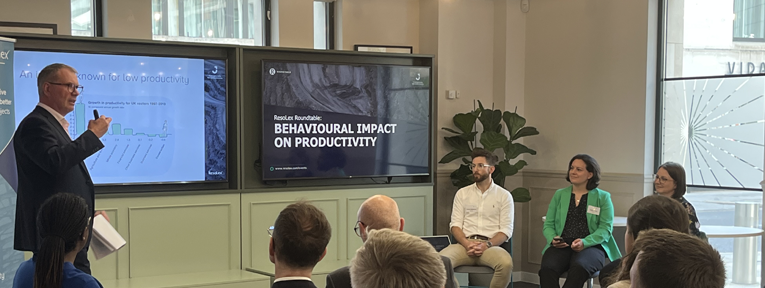
Jul 12, 2023 | Events, Roundtables
Last week, we were delighted to welcome three guest speakers from Jacobs to the ResoLex Roundtable: Jessica Ellery, Gail Hunter, and Joshua Weatherley. Jacobs is a full-spectrum professional services firm including consulting, technical, scientific and project delivery with a workforce of about 60,000 people worldwide.
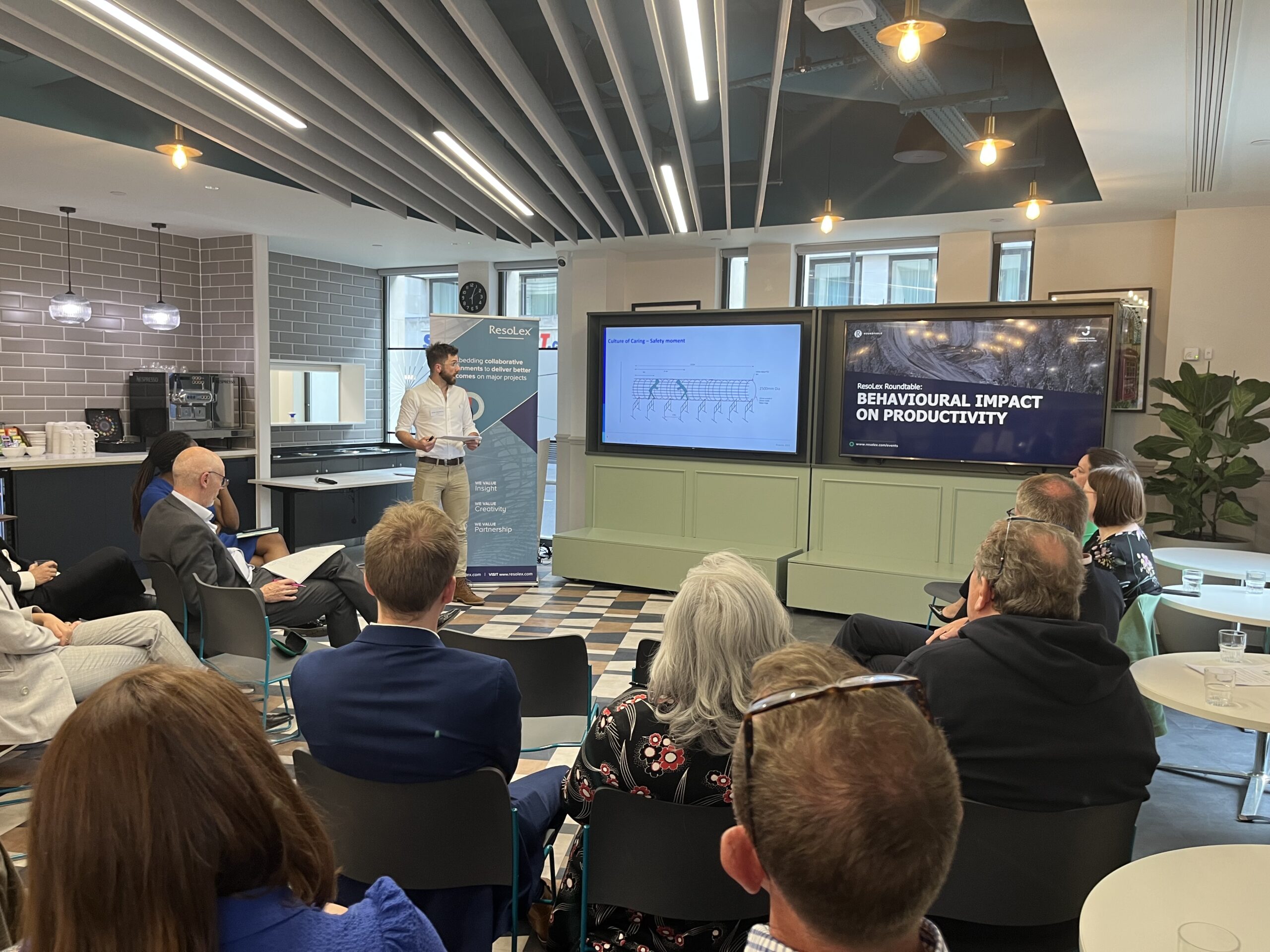
The evening was introduced by our Associate Director, Kelachi Amadi-Echendu, who provided some background to the ResoLex Roundtables and how the event links with our values as a business. Our Chief Executive, Edward Moore then introduced the topic, reminding us that whilst collaboration in itself may be very nice, if it doesn’t improve productivity, one has to question the point! At ResoLex, we see projects as comprising three primary areas of expertise: technical, commercial, and social. We believe that the key elements are interlinked, and the social component is inextricably linked to project performance. During the session, Ed highlighted our model, and expanded on the need to take an integrated approach to the three elements in order to achieve project success.
Jess, Josh and Gail explored the topic through the lens of a live giga project that is in its early stages of delivery in Saudi Arabia. A perspective offered was that perhaps the scale and longevity of such programs offered the chance to truly embed an effective, collaborative social system, even more so than the opportunity we have in the mega-project environment. The presentation began with a poignant safety moment, and then an introduction to four immense projects in the Neom region of Saudi Arabia. Each of these projects are hugely ambitious, the most dramatic being The Line. The Line is a revolution for urban living, which according to the plans will be 500m tall, 200 meters wide and a staggering 170km in length. Whilst a project of this scale is fascinating in itself, the evening’s platform served as the backdrop to a much broader discussion around the challenges of working in such a complex programme environment. Throughout the session, Josh and Gail prompted the audience with a range of engaging questions and themes designed to stimulate debate (a dangerous thing to do with a ResoLex audience!).
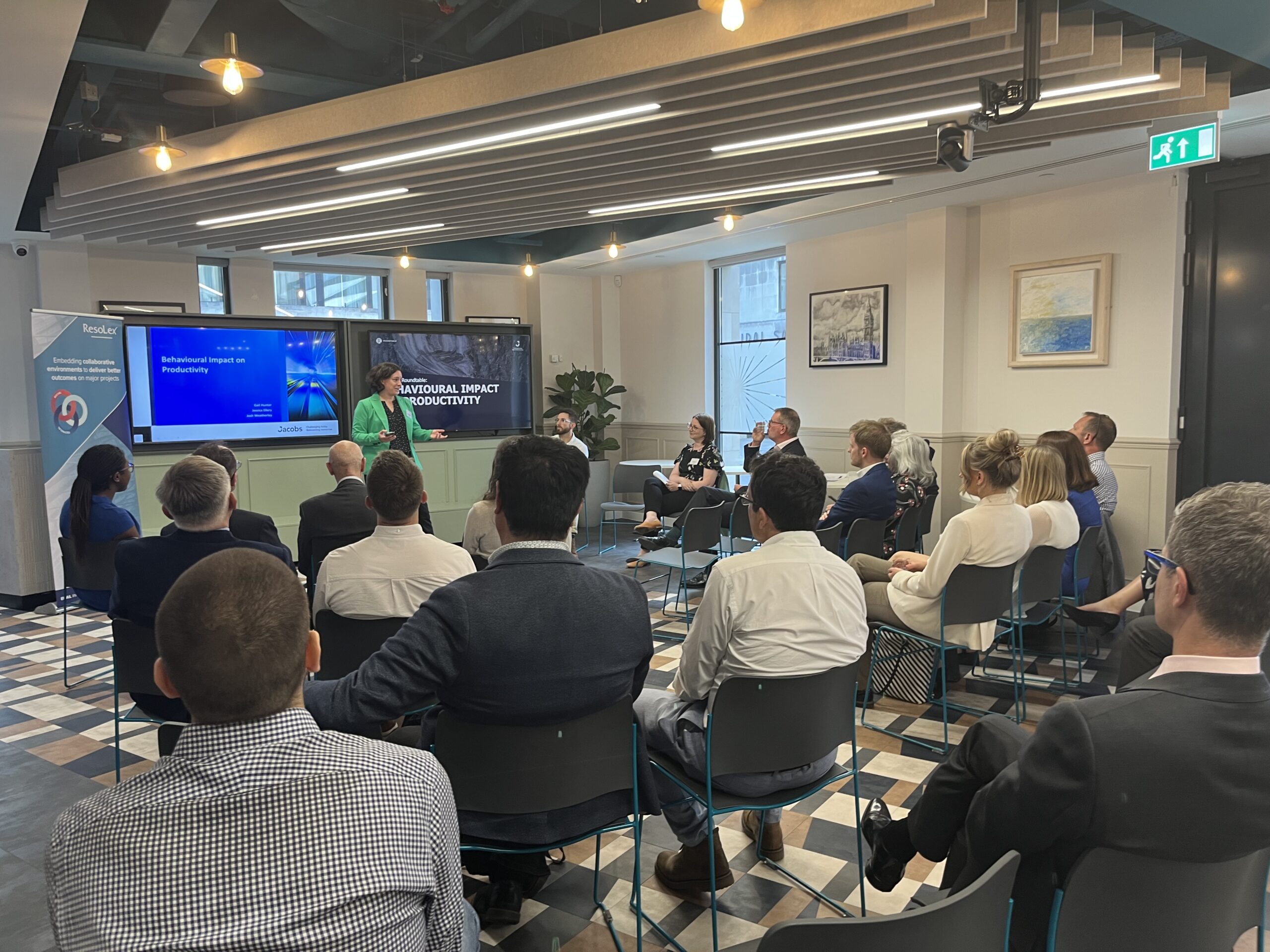
The presentation identified the challenges created by the multiple interfaces that must be managed by the teams and explained that this becomes exponentially more difficult to cope with as size and scale increase, supporting the initial introduction and highlighting the need to therefore factor in behaviours when setting the project strategy. This stimulated a lengthy discussion in the room around the more nebulous concepts of leadership and project culture, there was a common agreement that paying attention to these areas early in the programme is a critical success factor. It was also noted that one of the reasons for the poor performance of mega projects, in general, is the lack of ability for many project leaders to scale up from large projects, and when faced with high levels of complexity, they tend to fall back on simplistic solutions which inevitably fail in more complex and challenging environments.
So, what are the conclusions from the evening’s discussion? Here are our top five takeaways:
- There is a need to ‘operationalise’ collaborative intent. In other words, major projects (and especially giga projects) need to focus on establishing the policies and processes that will embed the principles of collaborative ways of working throughout the programme, rather than limiting the discussion to senior management.
- Focus on the active steps needed to build a positive culture, avoiding the default tendency to revert to transactional behaviours as soon as the project comes under pressure.
- The risk management process needs to acknowledge behavioural risk and recognise that effective inter-team relationships are both a risk and an opportunity.
- Relationship management plans should be a compulsory part of the early planning process and should focus on identifying the critical interfaces that need to be mapped and managed.
- Project leaders need to be trained specifically in the practical tools and techniques that will enable them to make the right decisions when working in highly ambiguous and complex environments.
The session closed with reference to the work of Edgar Schein, and his observation that for successful teams, people need to build ‘Level 2 relationships’ with their colleagues. This level of relationship is where we know enough about the people we work with on a regular basis to be able to see them as human beings, rather than just human ‘resources’, who carry out a functional role.
Overall, it was another stimulating and educational evening, with a wide range of views and opinions. As we see projects and programmes becoming ever more ambitious in their scale and desired outcome, the session is a reminder (should we need it!) that planning, setting up and mobilising for success from the start makes life considerably easier for the teams trying to deliver downstream.
If you’d like to join our next Roundtable, please keep an eye on our events page or sign up for our LinkedIn events newsletter.
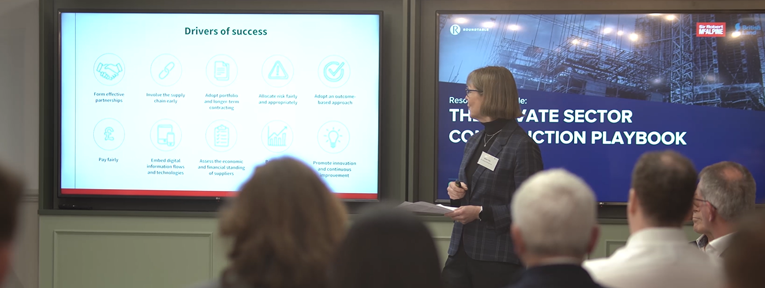
Mar 10, 2023 | Events, Roundtables
The discussion yesterday evening focused on the Private Sector Construction Playbook, a best practice guide published in November 2022. We were joined by two guest speakers, Alison Cox, Managing Director of Sir Robert McAlpine London Charles Horne, Project Director of British Land and, ResoLex Chief Executive Edward Moore.
Our Principal Consultant, Kelachi Amadi-Echendu began the session, by describing the journey from the government’s Construction Playbook to today’s Private Sector Playbook. She explained how the themes from the ResoLex publication ‘Changing Behaviours in Construction: A Complement to the Construction Playbook’, apply not only in the public sector but also to private sector projects and programmes, to enable improved delivery and better outcomes.
“Historically, the UK construction industry has been characterised by a lack of openness, poor productivity and a failure to invest in innovation”.
Foreword, Trust and Productivity The Private Sector Construction Playbook, November 2022
With many years of experience in the sector, driving excellence and delivering complex and challenging solutions for clients, we were delighted to have Alison Cox join us. Alison began explaining that the Private Sector Playbook was created by the construction productivity taskforce, a working group of developers, contractors, suppliers and professional service providers from the private sector whose underlying purpose is to try and improve productivity in the construction industry. She noted that whilst productivity had improved in a number of sectors, construction productivity had actually declined by 0.6% in the last 20 years. The document was designed to complement the Public Sector Construction Playbook that was released in 2020, taking cues from the public sector whilst understanding the challenges faced by the private sector.
The Playbook is structured around ten key drivers for success, as illustrated in the diagram below. It is interesting to note that half of these focus on culture and behaviours. Alison emphasised the need to concentrate on building the right relationships, particularly at the beginning of a project. She mentioned her own experiences on the construction of the Bloomberg offices where key members of the different teams sat in close proximity in a co-located office. This was a project that was quite dynamic and required the team to be highly adaptable to changes in requirements. The strength of relationships established in the early phases of the project enabled the teams involved to focus on ‘best for project’ decisions, rather than solutions which might be best for individual organisations.
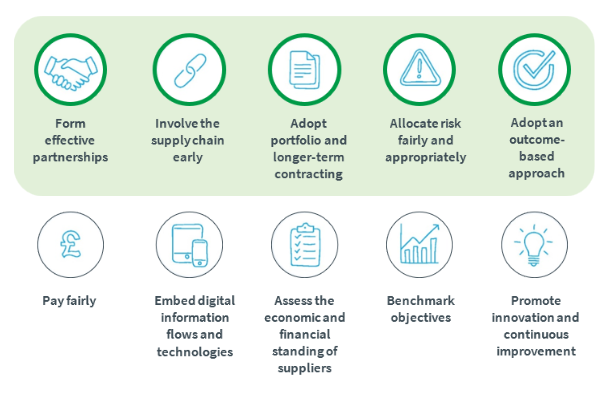
Charles observed the many changes in the construction industry since his experiences working on sites in the mid-1980s, as illustrated by the massive shift in safety that now exists compared to forty years ago. He highlighted the cultural change around health, safety and wellbeing, which simply did not feature when he first began his career. His primary observation is that projects are delivered by people rather than by technology or process. His recent experiences are drawn from Broadgate, where British Land is developing seven consecutive significant buildings under the Broadgate Framework. His starting point for creating the development strategy was the recognition that the customers for these properties are the local users in the area, and as such, care needs to be taken to avoid creating major disruption as the construction works to proceed. Charles’ approach required working with partners rather than suppliers, and so, in a significant break from traditional procurement practices, British Land has entered into a 10-year framework agreement with Sir Robert McAlpine. The framework enables British Land to reduce the risk of multiple concurrent projects and promotes consistency, continuity and innovation.
Contractual mechanisms aside, Charles, focused from the start on establishing an underlying ethos for the programme, based on the principles of Trust, Honesty and Collaboration. These principles have been developed into a set of rules, which every individual involved in the projects are expected to follow. The rules are generally self-policed, and there are very few instances where they are not applied by the numerous teams engaged in the programme. Charles identified a critical role that leadership plays in establishing a successful culture, recognising that in a collaborative contract, leaders need to be skilled at building ‘followership’.
He recognised the challenges of complexity and used the analogy of a pebble dropping into a pond and creating small waves. As projects grow in size and scale, leaders must deal with the challenge of lots of pebbles, dropping into the pool at the same time each creating ripples which intersect and disrupt with each other. He agreed with Alison that co-location is a critical factor in building cohesive and collaborative teams and is fundamental to building teamwork and understanding.
Ed Moore identified the need to establish the right culture from the start, quoting Abraham Lincoln, who said ‘give me six hours to chop down a tree and I would spend the first four sharpening the axe’. Ed made the case that programmes should treat relationship development as a distinct and separate workstream with its own targets and deliverables. Ed observed that too many project leaders tend to assume that their teams will naturally form into collaborative teams and therefore ignore the opportunity to shape the behaviours which occur at the very start. Ed also highlighted the need for project and programme teams to introduce a framework to help teams structure their workstream, and gave an example of the ASARI framework created by ResoLex as illustrated below:
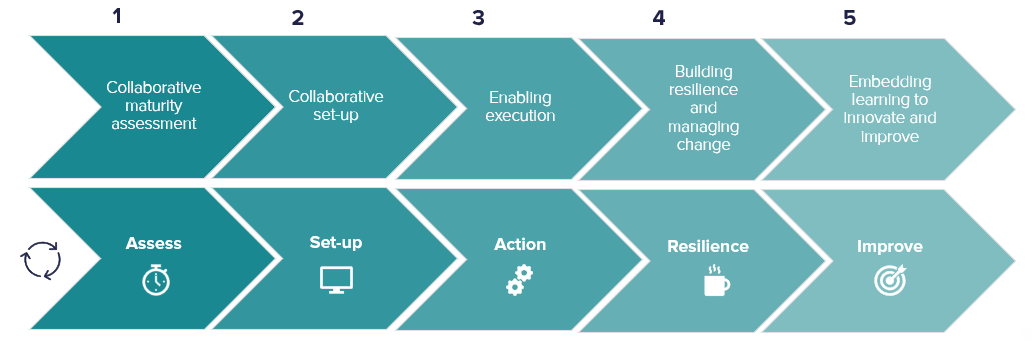
Some of the key points of the discussion from the floor, were as follows:
- Project culture is directly linked to the quality of leadership.
- A critical skill for project leaders is to learn to listen to other points of view rather than press on with their sole perspective as to how a problem should be solved.
- The time for the individual heroic project director has passed. The role of the project director is now to build leadership throughout the team.
- The primary barrier to industry-wide adoption of the Private Sector Playbook remains a driver amongst many clients to appoint the lowest tender, thus propagating the bad habits, behaviours and relationships that inevitably emerge from such practices.
- The key to wider adoption must be to focus on being able to clearly articulate the difference between value over cost and use the successes of previous projects to persuade others to continue to support a route based on effective relationships.
As a final comment, Charles pointed out that on Broadgate, each of the individual projects is still negotiated within the framework. He nevertheless observed that not one contractual letter has yet been issued by either party throughout the delivery of the programme. As he put it, when a difficult issue arises it is ‘our’ problem, not just ‘your’ problem. This is a great illustration of collaboration working in practice.
You can find the featured publications linked below:
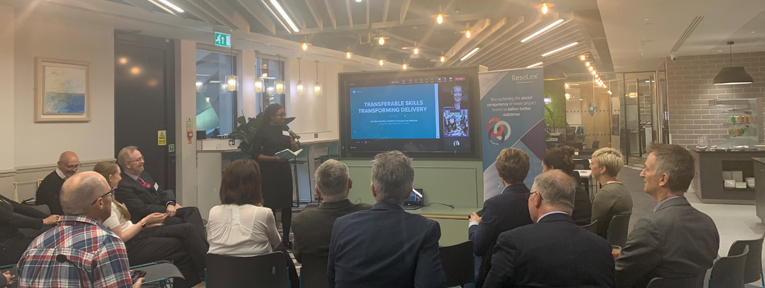
Nov 7, 2022 | Events, Roundtables
With guest speaker Rose McArthur, Director of Transport and Highways for Cheshire West and Chester Council and facilitated by Kelachi Amadi-Echendu, ResoLex
Kelachi opened the session with some background on ResoLex, explaining one of our underlying observations; projects rely on a triumvirate of competencies, technical, commercial and social. To set the landscape further, she highlighted a general challenge for lack of skills within the infrastructure sector. The skills problems begins at a high-level, so we have a technical challenge in areas such as climate change, as well as the economic challenges that organisations are wrestling with in a post-pandemic environment. The social component of major projects mentioned earlier encompasses these leadership challenges. The theme of the session was therefore to consider how we can bring people-oriented skills into the industry from other sectors whilst still appreciating the technical skills with career developments that aren’t necessarily leadership.
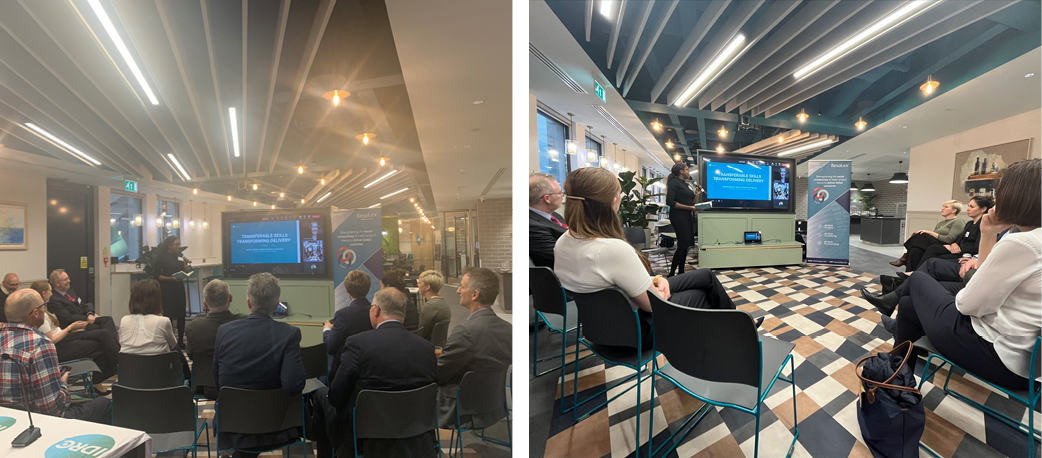
Rose started her presentation by talking about her own journey from being a Senior Consultant in a large engineering company, to a very different role in a local authority. Her background in integrated transport planning gave her the opportunity to work on huge projects such as the 2012 London Olympics, keeping people moving despite the challenge with an influx of people.
In her new role, she now has to focus on the practical problems within the highway sector exemplified by issues such as potholes, gulleys and pigeons. Many of the problems are much smaller in scale but there are huge amounts of them. Although Rose has a Director role and needs to strategically plan for the council’s transport and highways, many public enquiries are escalated to her due to a lack of communication from the project level and out to the local community.
Cheshire highways are a £5 billion asset, so there are many miles of road infrastructure that must be managed within very tight financial constraints. Rose made the point however that her biggest challenge is actually the people – as is the case in many engineering-focused teams, the historic basis for promotion is time served and technical expertise. Little concern has ever been paid to the skills of being customer focused and focusing strategically on future needs. All too often teams within the organisation have a silo mindset, and it is therefore difficult to get them to engage in new concepts outside of their core areas of expertise. So when it comes to management skills, technical competency is probably only around 25% of what is needed. Instead, there is a critical need for skills in communication, people management, delivering change, and the ability to engage a wider stakeholder group. Of course, some people with these technical skills may thrive in leadership and management roles but only with the right effort put into training – these important skills need development and training.
In developing her teams, Rose has found that she must therefore expand her search horizons when looking for new recruits. For example, she believes that change starts with the data-led approach, so the ability to analyse and communicate trends and issues is critical. She is also seeking people who have effective communication skills so that stakeholder relationships can be managed more effectively. More often than not, she has to go outside of the organisation to look for people in other sectors and industries to get the less technical but more strategic types of people to therefore reach the balanced team she requires.
Thoughts and observations from the floor included the following:
- An example was given of the huge value provided by somebody who had a passion for the environment but who originally came from a role in finance.
- Bringing in new skills and perspectives is important, but to be successful organisations need to be ready for the disruption they may cause. For example, construction firms are often not comfortable with people who are trying to push a different way of thinking.
- Leadership is critical in changing mindsets and behaviours. An example was given from a major programme where one of the senior leaders attended the sustainability group which significantly boosted attendance and output.
- There is a distinct leadership skill set around managing complexity and ambiguity.
- Creating resilient teams is one of the keys to survival in the 21st century, where leaders surround themselves with people who support each other in pursuit of a common goal.
The underlying message from the session is that in organisations that need to change, there needs to be a shift in the types of skills and competencies that may not be present in the current structure. The technical element which used to be dominant in many engineering-oriented businesses are still important, but at leadership, the level must often be subordinated to the ability to manage the problems created by complexity, scale and pressure on resources. The challenge for all organisations involved in infrastructure is to identify the different skills needed and create an environment which will encourage bright people to come and join them.
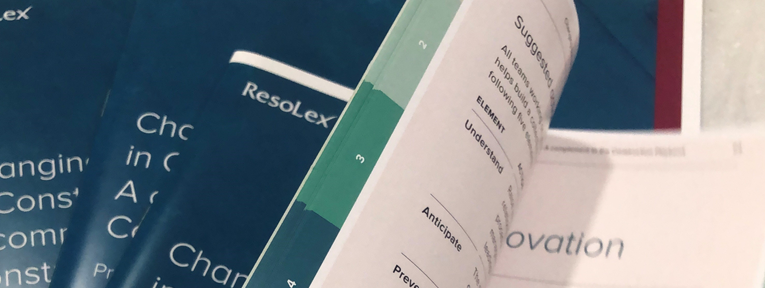
Jul 12, 2022 | Events, Roundtables
Putting The Construction Playbook into Practice – 30th June 2022
Facilitated by Ed Moore and Kelachi Amadi-Echendu
ResoLex’s Roundtable series recommenced with our first in-person session since Autumn 2019 and in our new home – you may have seen, we have relocated along with our friends from the International Dispute Resolution Centre to Paternoster Lane right next to the beautiful St. Paul’s Cathedral – where we welcomed a select group to delve into some of the key aspects of The Construction Playbook.
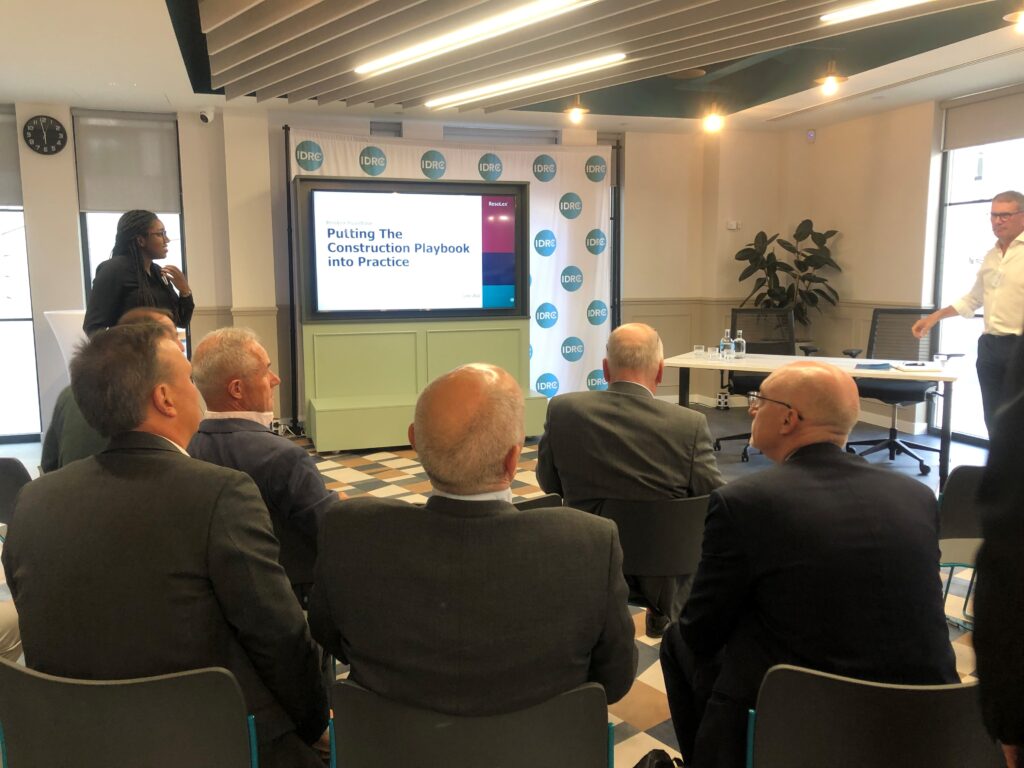
Our Chief Exec, Ed opened the session by setting out our view that the success of major projects hinges on three critical interlinked elements; Technical, Commercial and Social. His observation is that The Construction Playbook continues the worthy objective of modernising the construction industry. However, reading through the document one can see that its focus is primarily on a project’s technical and commercial elements, but has little to say on the social element, on the people that deliver projects.
Our Senior Consultant, Kelachi then introduced the report we recently produced, Changing Behaviours in Construction: A complement to The Construction Playbook. The report brings together our experience and contributions from our Associates and is designed to act as a complement to The Construction Playbook. It provides practical guidance on the behavioural and cultural elements that supplement some of the key recommendations in the Playbook, focusing on actions and activities that we know through our experience help to build a project’s ‘social capital’.
Our Roundtable sessions are designed to be an interactive discussions rather than a lecture. We, therefore, had an interactive session with participation from everyone in the room, offering a range of perspectives around two key topics:
- Collaborative Leadership
Leadership has been a hot topic within the industry lately. Kelachi pointed out that it is discussed throughout our report and was recently raised in the second iteration of the ICE review: A Systems Approach to Infrastructure Delivery. An article in the NCE references the report as identifying the need for projects to move on from the habit of appointing ‘hero leaders’ – you can find the full article here.
There was consensus in the room that when faced with complexity, there is a need to adopt different leadership styles and attributes and, that collaborative leadership is desirable, but it is probably more important to embed the right culture at the start. The discussion also brought out the recognition that the leadership needs of a project change as the project/programme moves through the cycle. In modern construction, leaders need to be truly agile, and able to adjust their approach depending on circumstances.
- Front End Loading
Ed picked up on the requirement in the Playbook to put more time into the start of a project to think through how a team will work together before moving into the task of construction. The question to the room was the extent to which this would add value.
The consensus was that time spent working through potential issues with the full design and delivery team, ideally producing a digital twin, would ultimately produce a better outcome. The proviso, however, was that project teams need to be clear on the main focus, as time can easily be frittered away on inconsequential matters.
The other challenge identified is that upfront investment in building relationships could be wasted if individuals involved in the early stages of a project then quickly moved on to other projects or roles. The answer to this problem was seen to be the need to proactively establish a strong culture so that new entrants to the project would quickly pick up the required mindset and behaviours set out in the beginning.
Summary
Taking an overview of the evening’s discussion, the common perspective was a recognition that the social, and therefore people component is a key element in the shifting of behaviours to enable the construction industry to deal with the complexity and uncertainty that are features of our current environment. The industry must therefore focus more effort to train leaders in how to become more agile and understand how to build project cultures that will embed collaborative ways of working that will endure through the life cycle of a project.
You can access The Construction Playbook and our report through the links below:
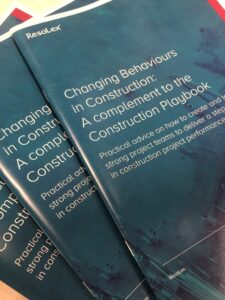
The Construction Playbook
Changing Behaviours in Construction: A complement to The Construction Playbook
Tony Llewellyn – 4 July 2022














